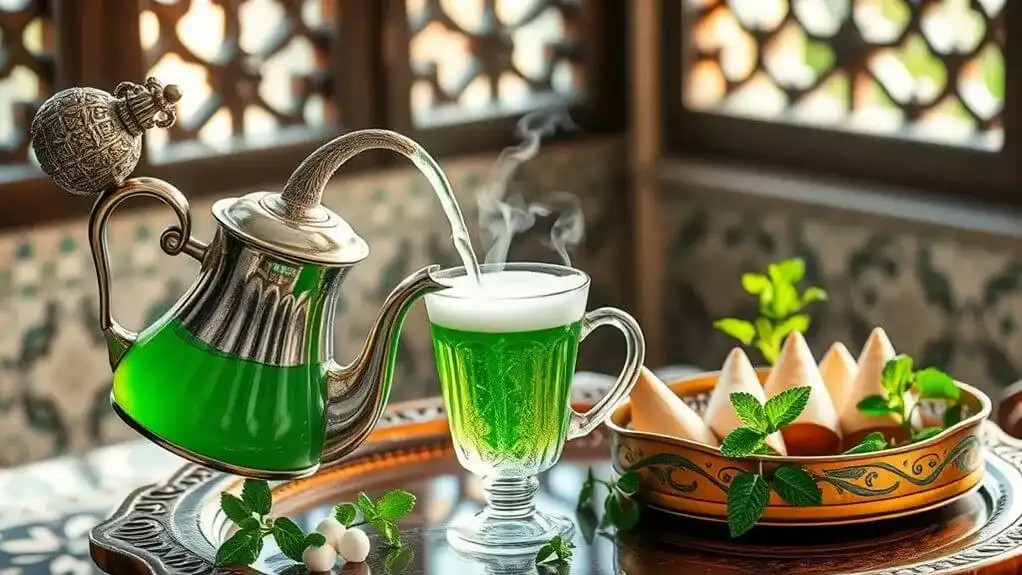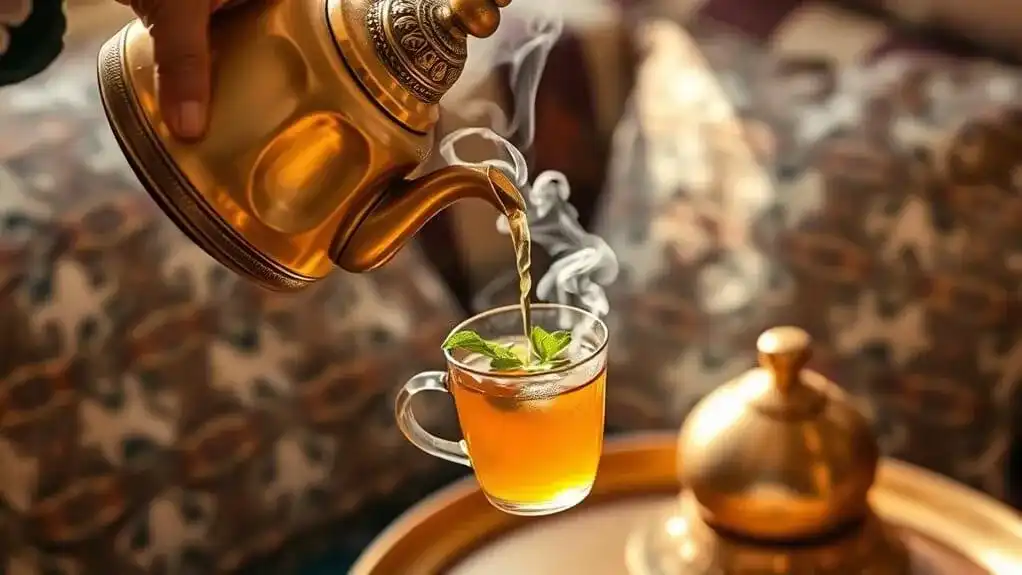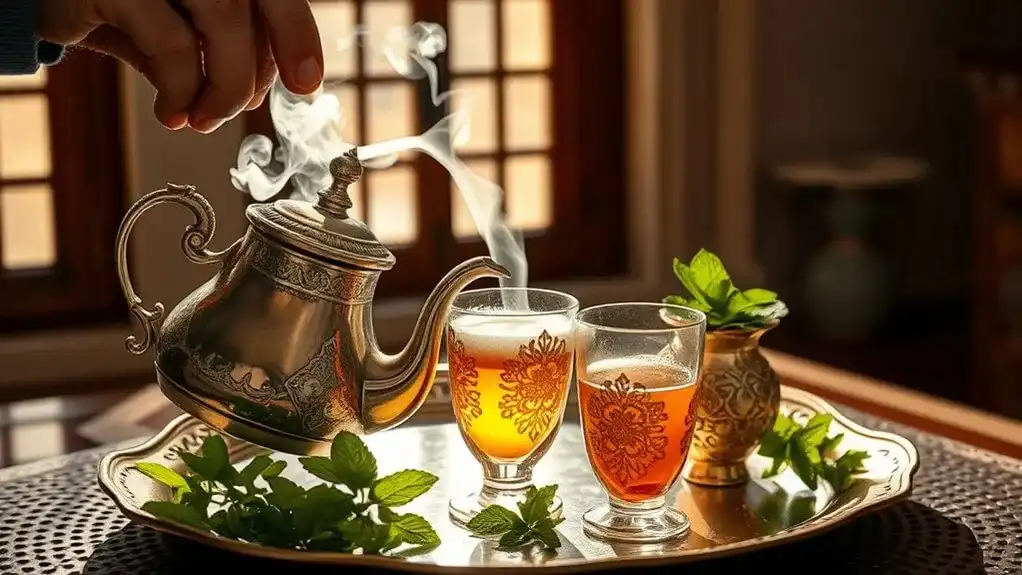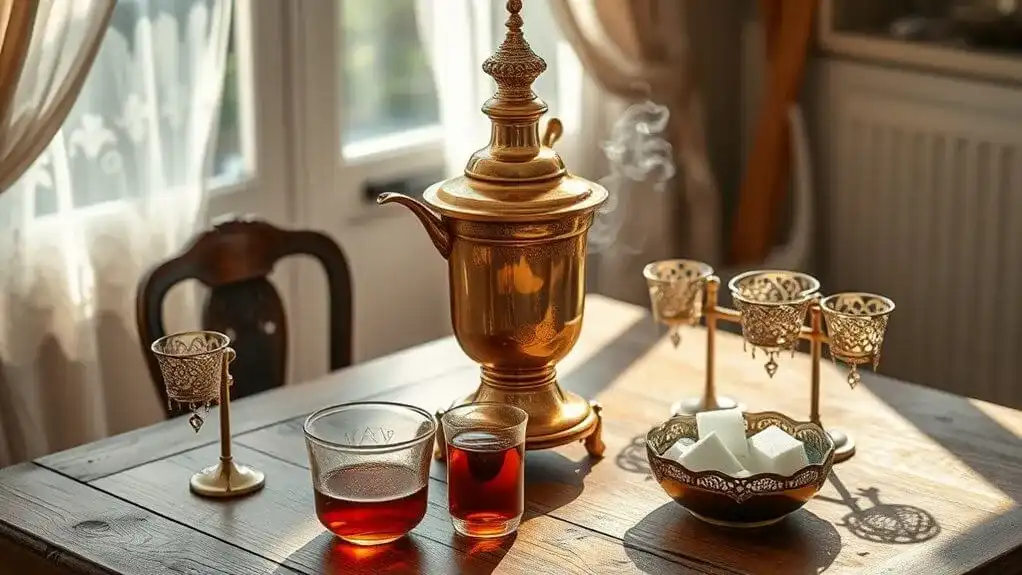Morocco's mint tea tradition stands as a cherished symbol of hospitality, dating back to the 18th century. The ceremony combines gunpowder green tea, fresh mint leaves, and sugar in a ritualistic three-pour process that represents life's journey from bitter to sweet. It's more than just a beverage – it's a social cornerstone where hosts serve guests clockwise in decorative glasses, embodying the philosophy that "the guest is king." The intricate details of this time-honored custom reveal layers of cultural significance.
Key Points
- Moroccan mint tea ceremonies symbolize hospitality through the ritualistic three-pour method, representing life's journey from bitter to sweet experiences.
- Tea preparation involves specific equipment, including hand-engraved teapots and traditional glasses, showing respect and care for guests.
- The host serves tea clockwise to guests, creating a strong social bond and demonstrating the cultural belief that guests are royalty.
- Fresh mint leaves and gunpowder green tea combine with precise brewing techniques to create a signature taste of Moroccan hospitality.
- The tradition embodies Morocco's philosophy of generous hospitality, making tea ceremonies central to social gatherings and cultural exchanges.
The Origins and Evolution of Morocco's Green Tea Culture

While the exact origins of Moroccan mint tea remain debated, its introduction to the country's culture took root primarily in the 18th century through various channels. Some historians trace its tea history back to the Phoenicians in the 12th century BC, while others point to the Berbers who first brought tea-like plants to the region. The most significant influence came through maritime trade routes and European connections.
A pivotal moment in this cultural exchange occurred when Queen Anne of England presented tea to Sultan Moulay Ismail's court, hoping to free British prisoners. Later, the Crimean War brought gunpowder green tea to Morocco, leading to its distinctive preparation with mint and sugar. This blend of influences shaped Morocco's unique tea tradition, incorporating elements from Berber, Arab, Andalusian, and British customs. The British merchants introduced what became a crucial component of Moroccan tea culture – the gunpowder tea leaves that pop distinctively when brewed. Before the introduction of green tea, Moroccans traditionally prepared their beverages using local aromatic herbs including wormwood, sage, and thyme.
A Symphony of Flavors: Essential Ingredients and Equipment

When preparing authentic Moroccan mint tea, the symphony of flavors emerges from a precise combination of essential ingredients and specialized equipment. At its core, gunpowder green tea serves as the foundation, while fresh mint leaves, including tea varieties like sheest and cultivated mint types, add the signature aromatic touch. Sugar, often in the form of a traditional sugarloaf, provides the characteristic sweetness. Five minute steeping allows the flavors to fully develop and meld together. The traditional ceremony requires that the head of household assumes responsibility for the tea preparation. The teapot's design features a flat bottom base that provides stability during brewing.
The preparation relies on specialized tools designed for both function and beauty. Hand-engraved Moroccan teapots, crafted to withstand high temperatures, are essential for proper brewing. These are accompanied by slender glasses that showcase the tea's distinctive foam and ornate silver trays for serving. Together, these elements create the perfect balance of taste and presentation that defines Morocco's cherished tea tradition.
The Sacred Art of the Three Pours

The art of pouring Moroccan mint tea transcends mere beverage service to become a sacred ritual steeped in symbolism and tradition. Each pour carries deep ceremonial significance, representing life's journey from bitter to sweet. The pouring technique, executed from a height of six inches, creates a distinctive froth while demonstrating the host's expertise and respect for guests. The master of the house serves as the traditional tea maker, maintaining centuries of cultural custom. Using the distinctive berrad teapot, the host carefully pours the aromatic blend of gunpowder tea and fresh mint.
The sacred ritual unfolds in these meaningful stages:
- First pour symbolizes "bitter as death," cleansing the palate
- Second pour represents "strong as life," awakening the senses
- Third pour embodies "sweet as love," bringing joy and completion
- Each pour strengthens the bond between host and guests
The host moves clockwise, serving guests with precision and grace, while traditional pastries often accompany this cherished ceremony that concludes with expressions of gratitude.
Mastering Traditional Brewing Techniques

Mastering the art of brewing authentic Moroccan mint tea requires meticulous attention to both ingredients and technique. The traditional tea brewing process begins with Gunpowder green tea leaves, which are first cleansed with a small amount of boiling water. Fresh Naa Naa mint leaves and sugar are then added to the cleaned leaves in a specialized Moroccan teapot. Refusing a cup during this ceremonial preparation may be interpreted as an insult to the host's hospitality. The tea is traditionally poured from height to create a signature frothy top that enhances presentation and taste.
The flavor infusion process follows a specific sequence. The first pour, known as Errouh, represents the tea's soul and is discarded before adding more boiling water. Initial steeping lasts just 1-2 minutes, with subsequent infusions requiring longer steeping times to develop different flavor profiles. Throughout the process, the tea maker must use a heat-resistant teapot that's compatible with various stove types, ensuring ideal brewing conditions. Many Moroccans select standard feet-free teapots to achieve optimal heat distribution on modern stovetops.
Modern Hospitality Meets Ancient Custom

Modern Moroccan hospitality artfully bridges ancient customs with contemporary luxury, creating an experience that honors centuries-old traditions while embracing present-day comforts. The cultural significance of mint tea remains a cornerstone of social gatherings, whether served in luxury resorts like Royal Mansour or traditional riads. This cherished ritual has adapted seamlessly to modern settings while maintaining its essence. In Morocco, the tradition embodies the cultural philosophy that the guest is king, making every visitor feel like royalty through the tea ceremony. The practice of pouring from height showcases the host's expertise while adding dramatic flair to the serving ritual. Guests are warmly greeted with a customary Salaam Alykum before the tea service begins.
Today's hospitality venues honor this tradition in innovative ways:
- Boutique hotels incorporate traditional tea ceremonies into their welcome experiences
- High-end resorts offer curated tea-tasting workshops that explore regional variations
- Contemporary cafes reinvent the three-round serving ritual for modern patrons
- Luxury properties blend ancient tea customs with wellness experiences
This evolution demonstrates how Morocco's hospitality sector successfully preserves its authentic heritage while catering to contemporary travelers' expectations.
Conclusion
Morocco's mint tea tradition isn't just a delightful pick-me-up; it's the heartbeat of the nation's social fabric. When life moves at lightning speed, this cherished custom offers a gentle reminder to pause and connect. Whether shared in a modern café or a traditional home, the familiar dance of the three pours continues to weave its magic, keeping Morocco's spirit of hospitality alive and flowing like liquid gold.

